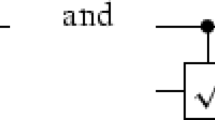Abstract
In this paper, we employ affine symplectic space \({ASG(2\nu,\mathbb{F}_q)}\) as a tool to construct two new classes of d e-disjunct matrices. The efficiency ratio of new d e-disjunct matrices is smaller than that of D’yachkov et al. (J Comput Biol 12:1129–1136, 2005).
Similar content being viewed by others
References
Du D.-Z., Hwang F.K.: Combinatorial Group Testing and its Application. 2nd edn. World Scientific, Singapore (2000)
Du D.-Z., Hwang F.K.: Pooling Designs and Nonadaptive Group Testing. World Scientific, Singapore (2006)
D’yachkov A.G., Hwang F.K., Macula A.J., Vilenkin P.A., Weng C.: A construction of pooling designs with some happy surprises. J. Comput. Biol. 12, 1129–1136 (2005)
D’yachkov, A.G., Macula, A.J., Vilenkin, P.A.: Nonadaptive group and trivial two-stage group testing with error-correction d e-disjunct inclusion matrices. In: Entropy, Search, Complexity, vol. 16, pp. 71–83. Springer, Berlin, Heidelberg (2007)
Gruenberg K.W., Weir A.J.: Linear Geometry. Springer, New York (1997)
Huang T., Weng C.: Pooling spaces and non-adaptive pooling designs. Discrete Math. 282, 163–169 (2004)
Lang W., Wang Y., Yu J., Gao S., Wu W.: Error-tolerant trivial two-stage group testing for complexes using almost separable almost disjunct martrices. Discrete Math. Algorithms Appl. 1, 235–251 (2009)
Macula A.J.: A simple construction of d-disjunct matrices with certain constant weights. Discrete Math. 162, 311–312 (1996)
Macula A.J., Gal S., Andam C., Bishop M.A., Renz T.E.: PCR nonadaptive group testing of DNA libraries for biomolecular computing and taggant applications. Discrete Math. Algorithms Appl. 1, 59–69 (2009)
Marathe, M.V., Percus, A.G., Torney, D.C.: Combinatorial optimization in biology (2000, manuscript)
Ngo H., Du D.: New constructions of non-adaptive and error-tolerance pooling designs. Discrete Math. 243, 161–170 (2002)
Ngo H., Zu D.: A survey on combinatorial group testing algorithms with applications to DNA library screening. DIMACS Ser. Discrete Math. Theor. Comp. Sci. 55, 171–182 (2000)
Park H., Wu W., Liu Z., Wu X., Zhao H.G.: DNA screening, pooling design and simplicial complex. J. Comb. Optim. 7(4), 389–394 (2003)
Pardalos, P.M., Du, D.: Handbook of Combinatorial Optimization. Kluwer, Dordrecht, 5 Volumes: Volumes 1, 2, 3 (1998), Supplement Volume A (1999), Supplement Volume B (2001)
Wan Z.: Geometry of Classical Groups Over Finite Fields. 2nd edn. Science Press, Beijing (2002)
Wu W., Li C., Wu X., Huang X.: Decoding in pooling designs. J. Comb. Optim. 7(4), 385–388 (2003)
Author information
Authors and Affiliations
Corresponding author
Additional information
Suogang Gao: Support in part by Natural Science Foundation of China, (10971052); Natural Science Foundation of Hebei Province, China, (No. A2008000128).
Zengti Li: Support in part by Natural Science Foundation of Langfang Normal College, China, (LSZZ200901).
Hongjie Du, Yan Shi, and Weili Wu: Support in part by National Science Foundation under grants CCF 0621829 and 0627233.
Rights and permissions
About this article
Cite this article
Gao, S., Li, Z., Du, H. et al. Approaching pooling design with smaller efficient ratio. J Glob Optim 49, 125–135 (2011). https://doi.org/10.1007/s10898-010-9538-4
Received:
Accepted:
Published:
Issue Date:
DOI: https://doi.org/10.1007/s10898-010-9538-4




